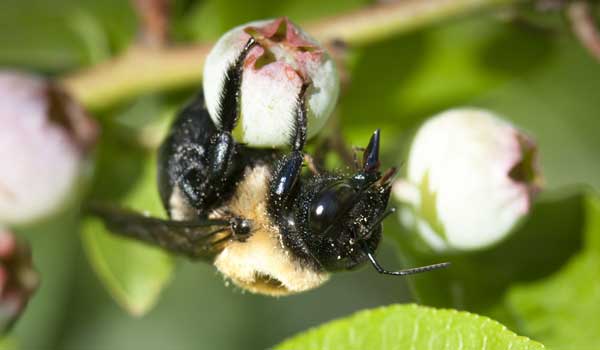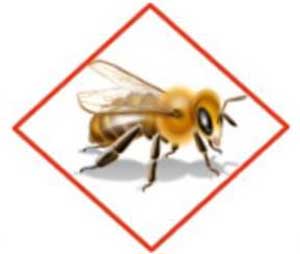
Pesticide Update:
Bee Advisory for Neonicotinoid Insecticides; Changes to Sandea Herbicide Label
Joe DeFrancesco, Oregon State University
Bee Advisory:
To protect bees and other pollinators, the Environmental Protection Agency is requiring that certain neonicotinoid insecticides include a “Bee Advisory Box” on the label that lists use restrictions and prohibits the use of the product if bees are present. The four neonicotinoid insecticides that must adhere to the new label ruling include clothianidin, dinotefuran, imidacloprid and thiamethoxam. Of the four, only imidacloprid and thiamethoxam are registered for use in highbush blueberries. Imidacloprid is the active ingredient in many commercially available products, such as Admire, Alias, Provado, et al. Thiamethoxam is the active ingredient in Actara and Platinum.
The EPA is currently working with pesticide manufacturers to change labels so that they will meet the Federal Insecticide, Fungicide and Rodenticide Act (FIFRA) safety standard. Growers will see these new labels sometime in 2014. The new labels will have a bee advisory box that makes clear the product can kill bees and other insect pollinators (to view an example of the bee advisory box, visit: http://www.epa.gov/pesticides/ecosystem/pollinator/bee-label-info-graphic.pdf). Application of the four targeted neonicotinoid pesticides is prohibited until after complete and final petal fall. The advisory box also includes spray drift precautions and information on how bees can be exposed to the product. The box will be clearly identified with a bee icon:

The new bee icon on neonicotinoid insecticide labels will warn users of additional rules they must follow to protect bees.
The EPA continues to evaluate the contribution of pesticides to Colony Collapse Disorder (a phenomenon where the majority of worker bees in a colony disappear and leave behind a queen, plenty of food and a few nurse bees to care for the remaining immature bees and the queen; without worker bees, the colony declines and can “collapse”.) It is generally believed that Colony Collapse Disorder (CCD) is related to a complex interaction of multiple stressor factors including: exposure to pesticides; pests, parasites and diseases; loss of habitat; nutrition; a lack of genetic diversity; et al. A recent report from the European Food Safety Authority indicates pesticides pose a “high acute risk” to bees; as such, the European Commission voted to restrict the use of clothianidin, imidacloprid and thiamethoxam on bee-attractive plants for two years (beginning Dec. 2013). The EPA has not taken such action at this time in hopes the new bee advisory labeling will help reduce bee kill and pesticide exposure contributing to Colony Collapse Disorder. It remains to be seen, however, if EPA will enact further restrictions on the four neonicotinoid pesticides or, possibly, expand the bee advisory labeling requirement to other classes of insecticide chemistries.
Further information about neonicotinoids and pollinator protection can be found at EPA’s website: http://www.epa.gov/pesticides/ecosystem/pollinator
Sandea Label Change:
Sandea herbicide has been registered for use in blueberries the past several years under a supplemental label. It can be absorbed through roots, shoots and foliage, is translocated within the plant, has both preemergence and postemergence activity and is very effective in controlling many broadleaf weeds and nutsedge.
The registrant, Gowan Company, recently added blueberries to their main federal label and, although the PHI is still 14 days and the REI is still 12 hours, there are a few important changes in the rate and use pattern that blueberry growers should be aware of.
The new Sandea label now has different application rates for plants of different ages. As before, Sandea cannot be used on plants that have been established less than one year. But now, for plants that have been established for 1 to 4 years, the rate is ½ to ⅔ oz. of product per acre; the rate for >4 years is ½ to 1 oz/acre (the previous rate, on the supplemental label, was ½ to 1 oz/acre for all ages). There is also now a restriction that applies specifically to the variety ‘Elliott’: “Do not apply to ‘Elliott’ variety bushes established less than four years.”
|
